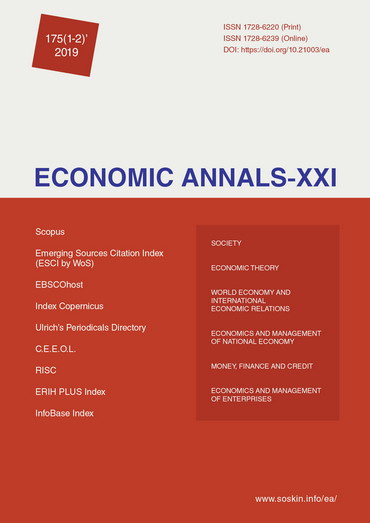Transparency of the enterprise: from theory to practice of evaluation (on the example of retail networks)
Transparency of the enterprise: from theory to practice of evaluation (on the example of retail networks)
Author(s): Natalia Krasnokutska, Olena Kruhlova, Victoria Kozub, Petra MartíškováSubject(s): Business Economy / Management
Published by: Institute of Society Transformation
Keywords: Transparency; Enterprise; Evaluation; Efficiency of Activity; Retail Network; Retail Chain; Profitability; Disclosure; ATB Market Ltd.; Fozzy Group; ECO Ltd.; RUSH Ltd.; Metro Cash & Carry Ukraine Ltd
Summary/Abstract: Introduction. In the conditions of globalisation of the world economy and informatisation of society, transparency is one of the most important factors of enterprise development. Openness of information concerning business organisation, performance of activities, implementation of innovations and social activity is a criterion for corporate management culture at the enterprise that determines its investment attractiveness and increasing market value, and creates preconditions for strengthening enterprises’ competitive positions in the market. Purpose. The purpose of the work is to identify the main elements of the enterprise transparency, substantiate methodological principles of its evaluation, conduct empirical research and test the hypothesis of the transparency impact on the main indicators of the enterprise activity. Methods. The methods of comparison, critical analysis and generalisation were used during the research, which allowed the authors to determine the essence, elemental composition and methodical principles for the evaluation of the company’s transparency. Also the methods of scoring, complex integrated assessment and correlation analysis were used to determine the level of transparency of retail networks by individual elements and study the link strength between transparency and the results of activities of trade enterprises. Results. According to the results of the research, the essence of transparency is defined as the transparency of relations between the company and its main stakeholders (owners, employees, buyers, resource providers, community, state), the content of which is disclosed through the set of characteristics of financial, legal, organisational, social anticorruption transparency. To determine the level of the enterprise transparency, a set of indicators reflecting transparency in the context of its main elements and formed based on the open data by enterprises, is substantiated. The conducted study of transparency of 25 Ukrainian retail chains made it possible to conclude that their level of openness is low (the level of transparency in general is 37.5% in aggregate). Only legal and financial aspects of the activities of enterprises among numerous types of transparency investigated are reflected in corporate websites in sufficient volume (56.6% and 54.2%, respectively). Also, we have determined formal disclosure of information concerning organisational structure of enterprises, associates and subsidiaries (36.0%), social activity (35.4%). The lowest level of openness of trade networks regarding the implementation of anticorruption programs (5.2%) is noted. According to the results of the correlation analysis, we have determined a strong dependence of profit dynamics (y1) of trading enterprises on legal (rx2y1=0.53), organisational (rx3y1=0.50) and financial (rx1y1=0.45) transparency. Also, a direct impact of legal (rx2y2=0.46), social (rx4y2=0.41) and anticorruption transparency (rx5y2=0.31) on dynamics of profitability of sales (y2) has been specified. Conclusion. Resulting from the research, transparency of the enterprise is defined as a complex characteristic, the content of which is disclosed through a set of relations between the company and its main stakeholders in the context of financial, legal, organisational, social and anticorruption openness. The authors of the article have detected a low level of transparency of retail networks in Ukraine and significant dependence of the results of their activity on the level of openness.
Journal: Економічний часопис - ХХІ
- Issue Year: 175/2019
- Issue No: 01+02
- Page Range: 58-62
- Page Count: 5
- Language: English

